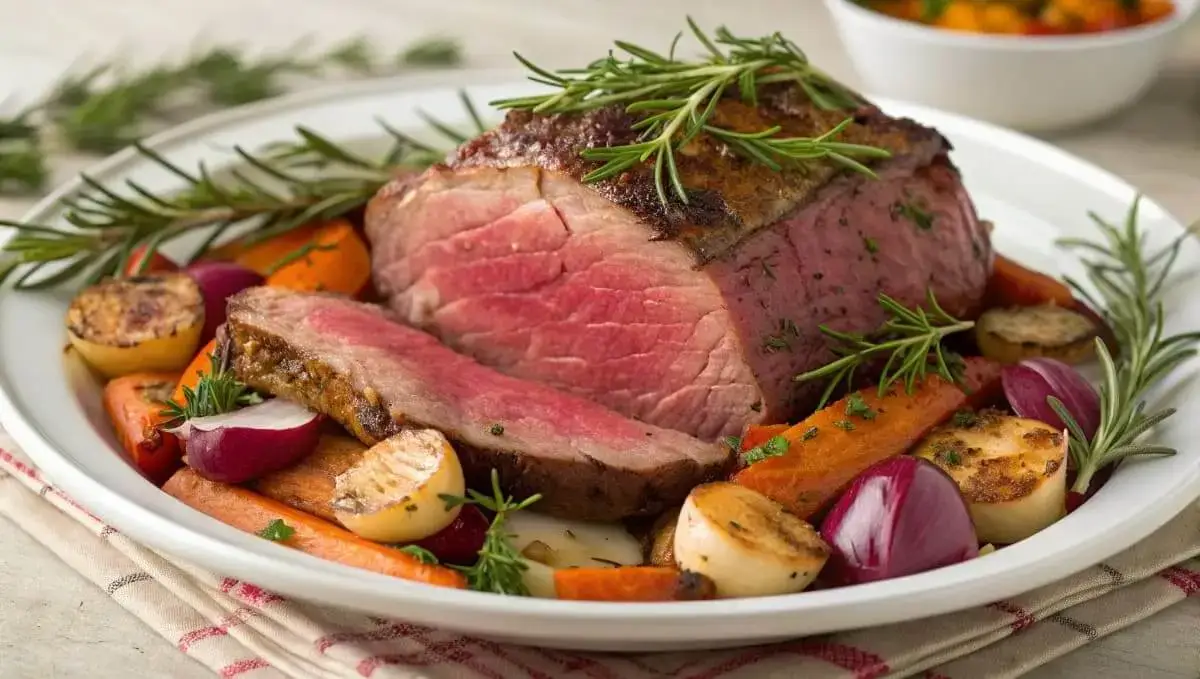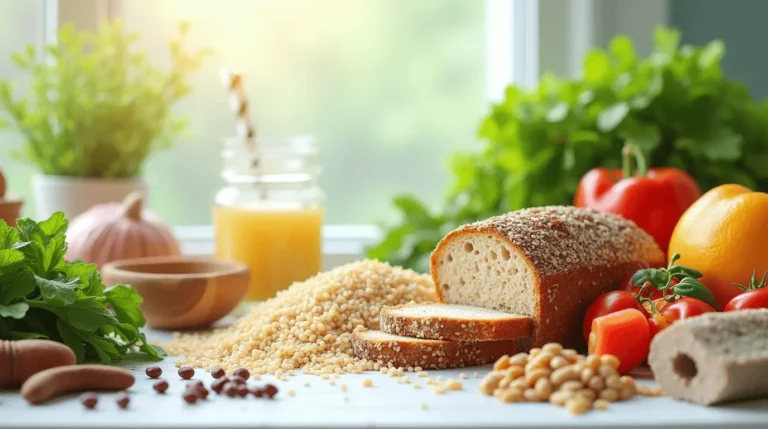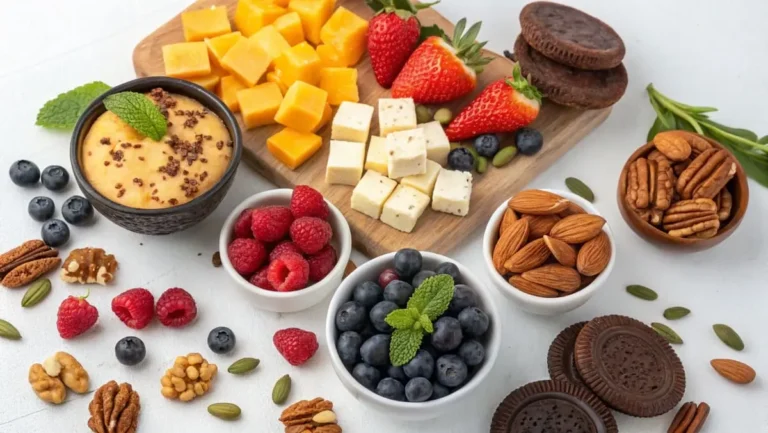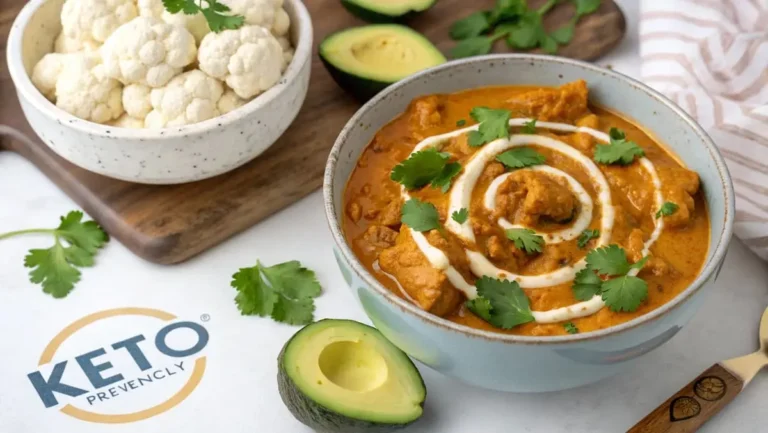The Easy Roast Beef with Roasted Root Vegetables
Hey there, food lovers! Are you craving a meal that’s both hearty and healthy, comforting and packed with flavor? Then you’ve come to the right place! Today, we’re diving into the wonderful world of Roast Beef with Roasted Root Vegetables. This isn’t just any dinner; it’s a classic, a celebration on a plate, and surprisingly easy to master in your kitchen.
Table of Contents
Why You’ll Love Roast Beef with Roasted Root Vegetables
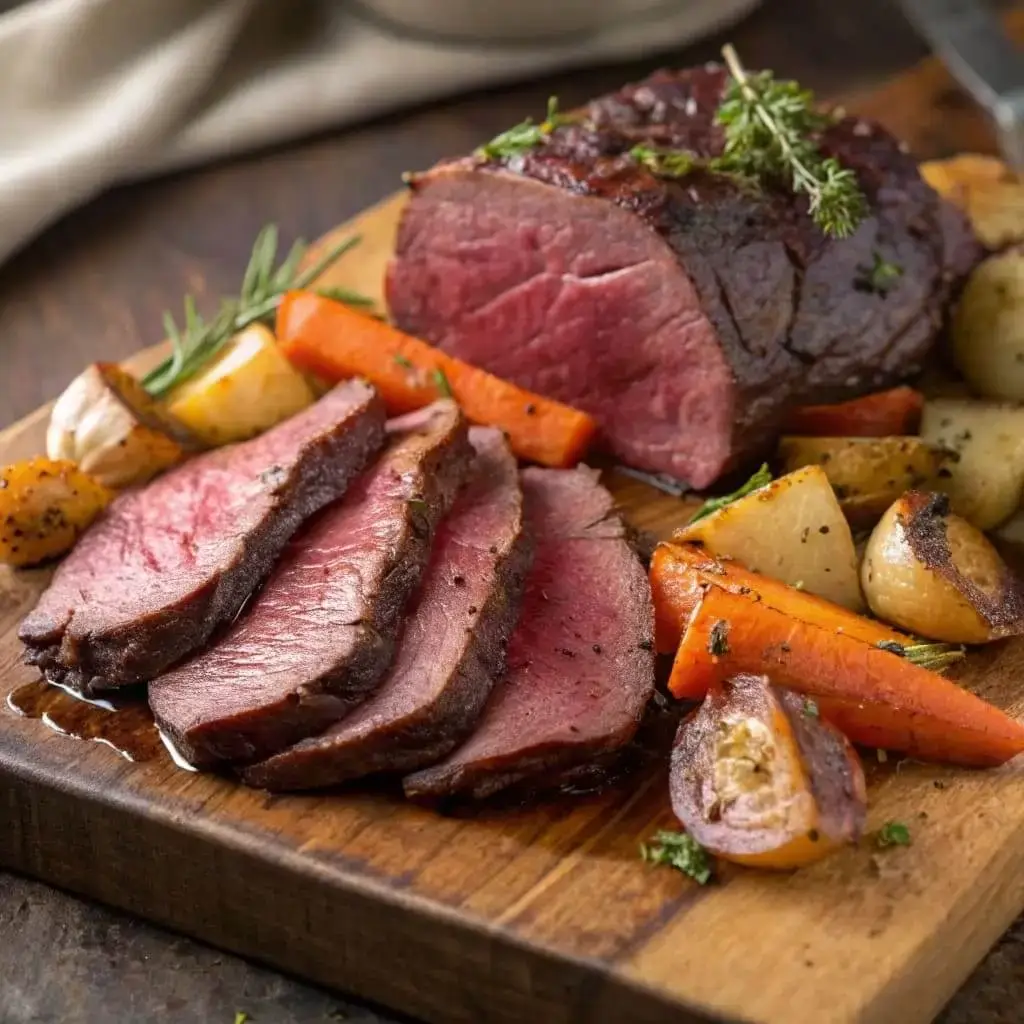
Let’s be honest, there’s something truly special about a roast beef dinner. It’s that aroma that fills your house, the tender, savory beef, and the naturally sweet and caramelized root vegetables. It’s the kind of meal that brings people together, perfect for a cozy Sunday supper or a special occasion.
But beyond just tasting amazing, Roast Beef with Roasted Root Vegetables is a winner for so many reasons:
- It’s Nutritious: You’re getting a fantastic dose of protein from the beef and a rainbow of vitamins and fiber from the root vegetables. Think of it as delicious for you!
- It’s Simple Elegance: While it feels fancy, roasting is a pretty hands-off cooking method. Once you get everything prepped, your oven does most of the work.
- It’s Versatile: You can adapt this recipe to your favorite root vegetables, and the leftovers are incredible! Think roast beef sandwiches, hearty salads, or even beef and vegetable hash.
- It’s Comfort Food at Its Finest: There’s just something inherently comforting about a warm, flavorful roast on a chilly evening. It’s food that nourishes the body and the soul.
Choosing Your Star Players: The Beef and Root Vegetables
To make the best Roast Beef with Roasted Root Vegetables, you need to start with quality ingredients. Let’s talk about the stars of our show:
Selecting the Right Roast Beef Cut
| Cut | Description | Flavor | Tenderness | Best Use for Roasting |
| Chuck Roast | From the shoulder, marbled with fat | Rich, Beefy | Becomes Tender | Budget-friendly, Flavorful needs longer cooking |
| Sirloin Roast | From the hip, leaner cut | Good Beefy | Tender | Leaner option, Shorter cooking time |
| Ribeye Roast | From the rib area, highly marbled, also called Prime Rib | Very Rich, Buttery | Very Tender | Most decadent, Rich flavor, Pricier |
For this recipe, you can use any of these cuts depending on your preference and budget. Chuck roast is a fantastic, more affordable option that becomes incredibly tender when roasted low and slow. Sirloin roast is a leaner choice, while ribeye roast (also known as prime rib) is the most luxurious and flavorful, perfect for a truly special occasion.
Pro-Tip: Don’t be afraid to ask your butcher for advice! They can help you choose the best cut for your needs and even trim it for you.
Root Vegetables: A Rainbow of Goodness
Root vegetables are the unsung heroes of this dish. They roast beautifully alongside the beef, becoming sweet and caramelized, and they offer a wonderful variety of textures and flavors. Here are some great options:
- Carrots: Sweet and earthy, they add a vibrant color and are packed with Vitamin A.
- Potatoes: Choose Yukon Gold for creamy texture or Russets for fluffiness. They soak up the delicious beef juices.
- Parsnips: Sweet and slightly nutty, they bring a unique flavor dimension.
- Turnips: Mildly sweet and slightly peppery, they add a bit of bite.
- Sweet Potatoes: Naturally sweet and creamy, they caramelize beautifully.
- Onions: While technically not a root, onions roast wonderfully and add savory depth.
Feel free to mix and match your favorites! Aim for a variety of colors for a visually appealing and nutritionally diverse dish.
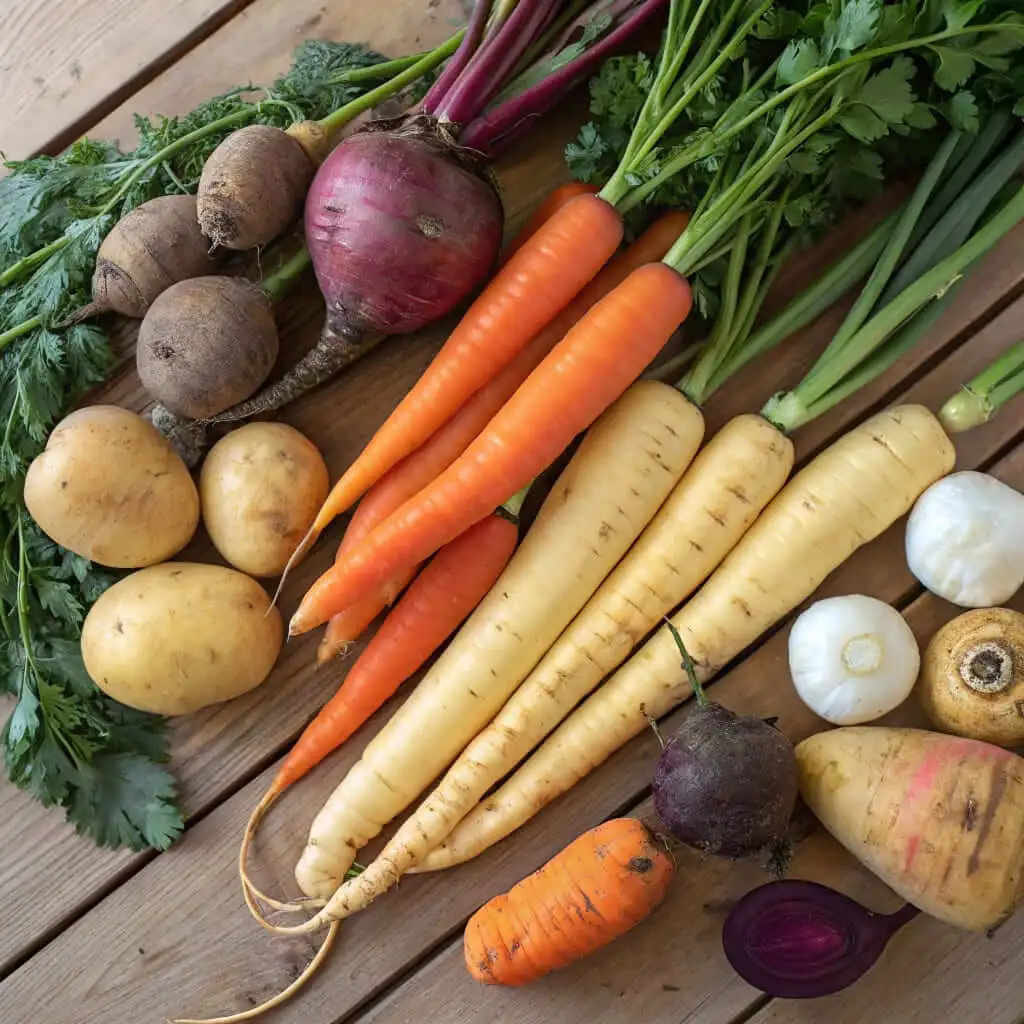
Your Step-by-Step Guide to Roast Beef with Roasted Root Vegetables
Recipe Card
- Yield: 6 servings
- Preparation Time: 30 minutes
- Portion Size: Approximately 1 ½ cups of roasted vegetables and 4-5 ounces (110-140 grams) of roast beef per serving.
Ready to get cooking? Here’s a simple and delicious recipe to guide you:
Ingredients You’ll Need
- 3-4 pound beef roast (chuck, sirloin, or ribeye)
- 2 pounds root vegetables, peeled and cut into 1-2 inch pieces (carrots, potatoes, parsnips, turnips, onions, sweet potatoes)
- 2 tablespoons olive oil
- 2 tablespoons fresh rosemary, chopped (or 2 teaspoons dried)
- 2 tablespoons fresh thyme, chopped (or 2 teaspoons dried)
- 2-3 cloves garlic, minced
- 1 teaspoon salt
- 1/2 teaspoon black pepper
- 1 cup beef broth (optional, for gravy – see ingredients to be careful of)
- 2 tablespoons butter (optional, for gravy – see ingredients to be careful of)
- 2 tablespoons all-purpose flour (optional, for gravy – see ingredients to be careful of)
Let’s Get Started: Prep Work is Key
- Preheat your oven to 375°F (190°C).
- Prepare the vegetables: Wash, peel (if needed), and cut your root vegetables into roughly equal-sized pieces. This helps them cook evenly. Toss them in a large bowl with 1 tablespoon of olive oil, salt, pepper, and half of the rosemary and thyme.
- Prepare the beef: Pat the roast dry with paper towels. This helps it brown nicely. In a small bowl, combine the remaining olive oil, rosemary, thyme, minced garlic, salt, and pepper. Rub this mixture all over the beef roast.
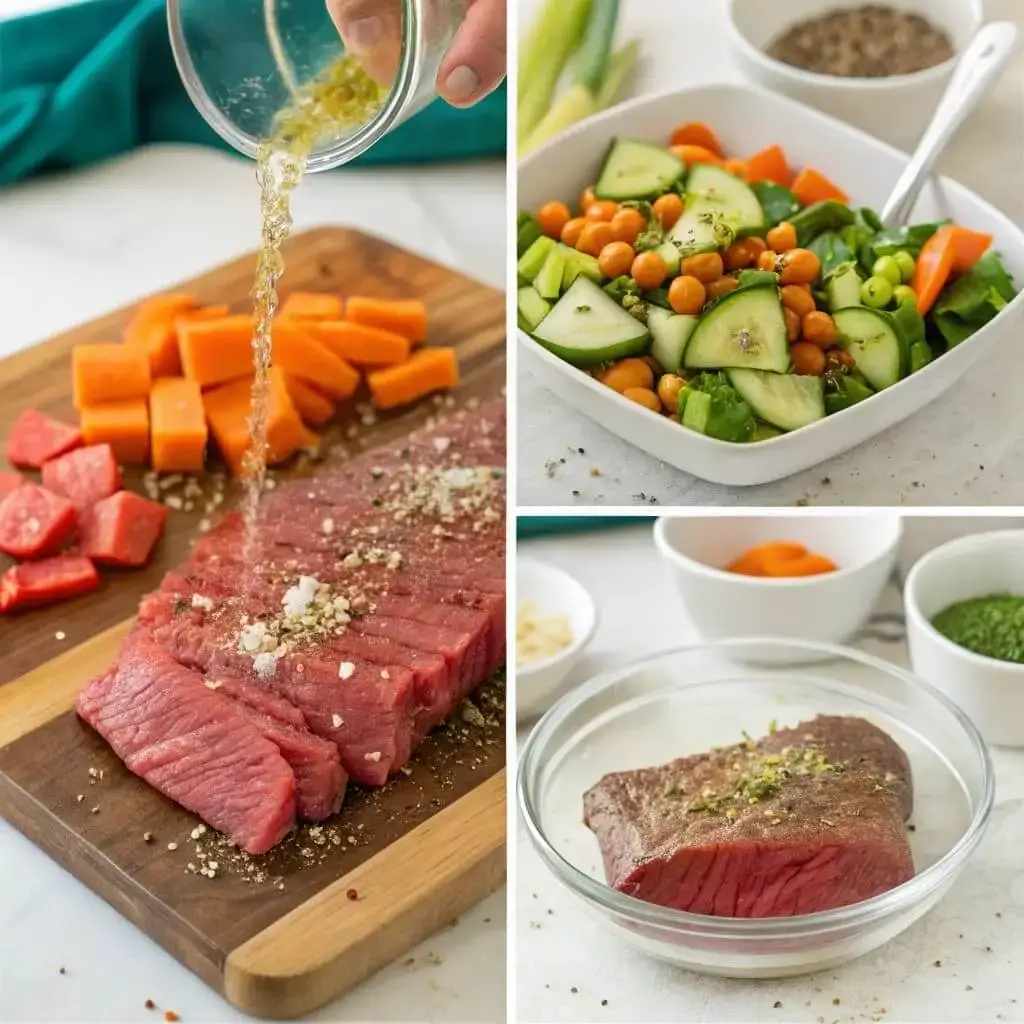
Roasting to Perfection: Beef and Vegetables Unite
Oven roasted beef and vegetables
- Arrange the vegetables in a large roasting pan. Place the beef roast on top of the vegetables or on a roasting rack set inside the pan.
- Roast for approximately 1 hour and 15 minutes to 2 hours, or until the beef reaches your desired level of doneness (see guide below). Use a meat thermometer to check the internal temperature.
- For Medium-Rare: 130-135°F (54-57°C)
- For Medium: 135-140°F (57-60°C)
- For Medium-Well: 140-145°F (60-63°C)
- For Well-Done: 145°F+ (63°C+) (Note: Roast beef is best enjoyed medium-rare to medium for tenderness.)
- Let it rest! Once the roast is cooked, remove it from the oven and transfer it to a cutting board. Tent it loosely with foil and let it rest for at least 10-15 minutes. This allows the juices to redistribute, resulting in a more tender and flavorful roast.
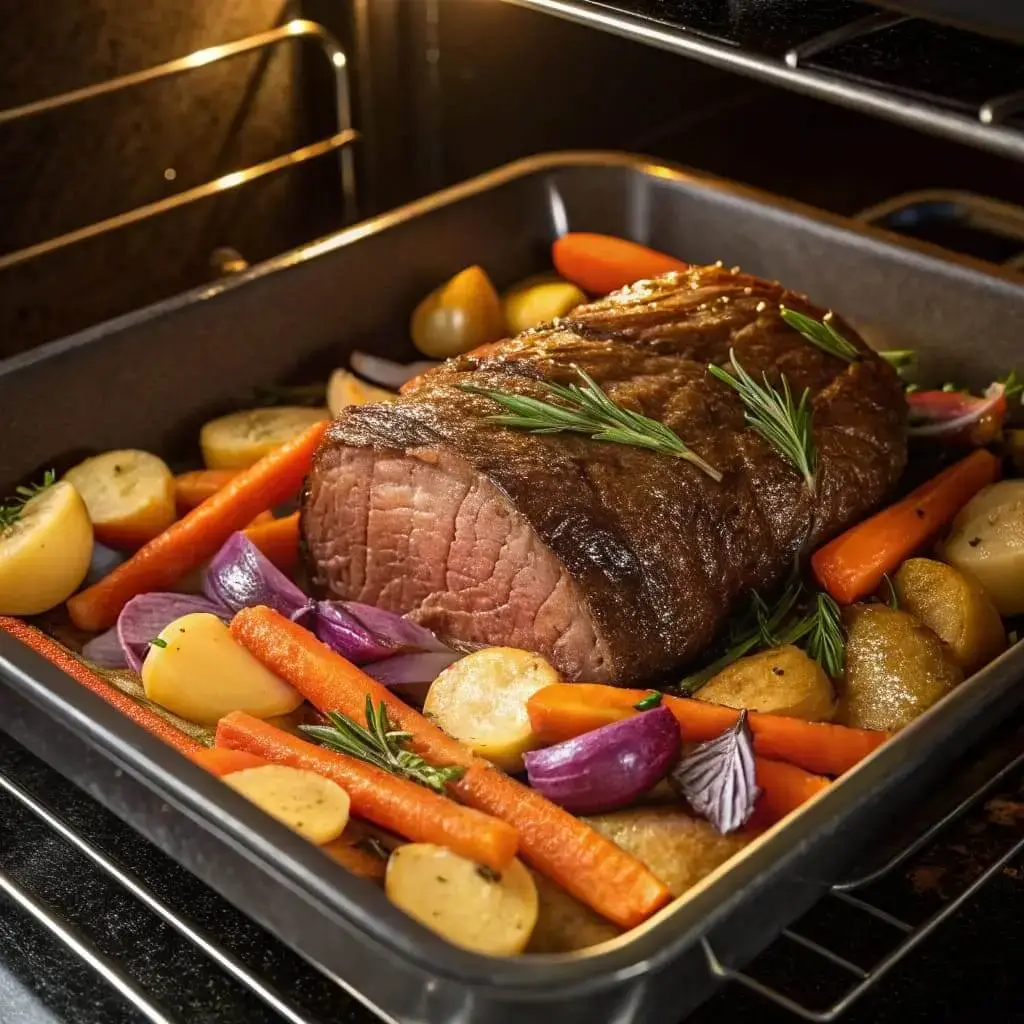
Making a Delicious Gravy (Optional, but Highly Recommended!)
While the roast is resting, you can make a simple gravy using the pan drippings.
- Skim off excess fat from the roasting pan, leaving the flavorful drippings.
- Place the roasting pan over medium heat on your stovetop.
- Melt butter in the pan drippings.
- Whisk in flour and cook for 1-2 minutes, stirring constantly, to create a roux.
- Gradually whisk in beef broth, scraping up any browned bits from the bottom of the pan.
- Bring to a simmer and cook, stirring occasionally, until the gravy thickens to your desired consistency.
- Season with salt and pepper to taste.
Serving Suggestions: The Grand Finale
“A good roast dinner is the cornerstone of a happy home.” – Unknown
Slice the Roast Beef with Roasted Root Vegetables against the grain and serve it immediately, spooning the roasted vegetables and gravy (if made) over the top.
Here are some serving ideas to elevate your meal:
- Classic Sides: Yorkshire pudding, mashed potatoes, green beans, or a simple side salad. ( Note: Consider dietary needs when choosing sides. Yorkshire pudding and mashed potatoes may not be suitable for gluten-free or low-carb diets.)
- Wine Pairing: A robust red wine like Cabernet Sauvignon or Merlot pairs beautifully with roast beef.
- Bread Basket: Serve with crusty bread for soaking up the delicious gravy. (Note: Bread is not suitable for gluten-free or low-carb diets. Offer gluten-free bread options if needed.)
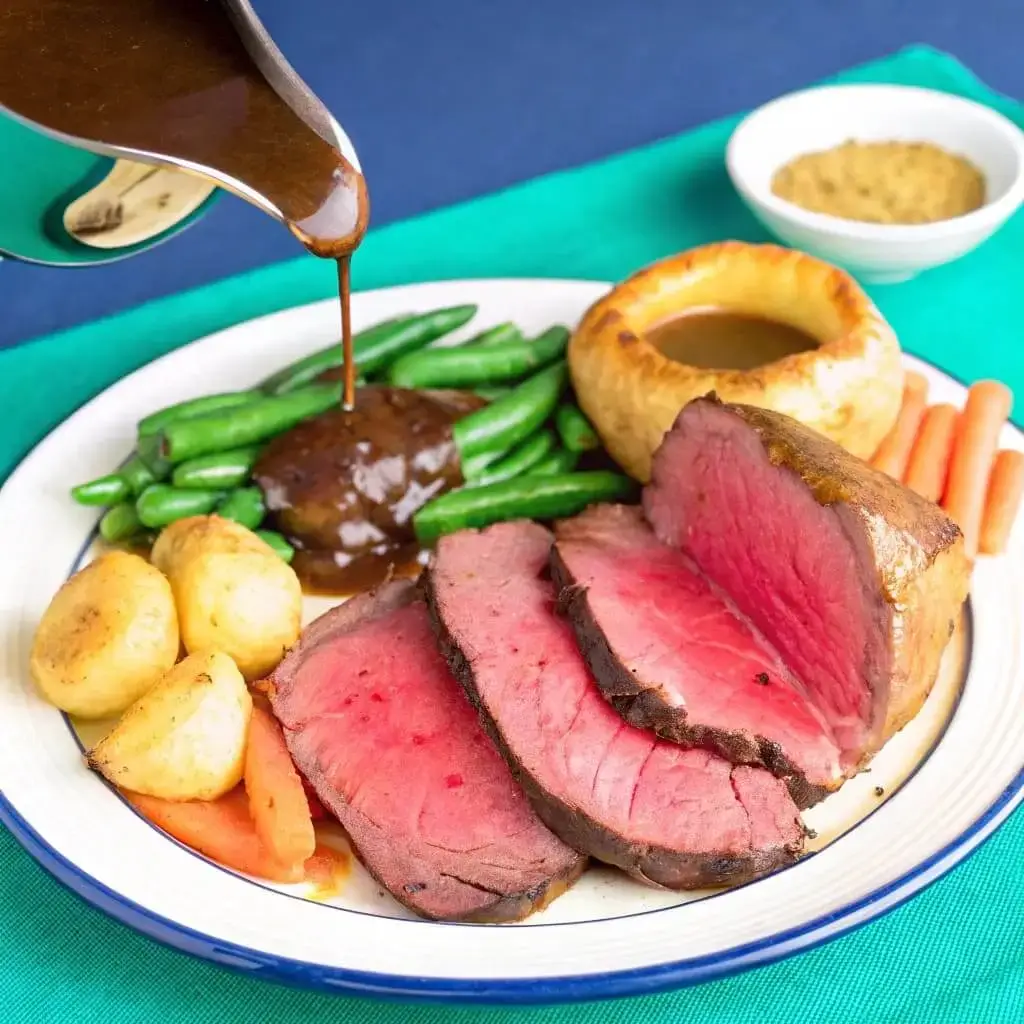
Ingredients to be careful of and Dietary Restrictions:
- Gluten: Traditional gravy uses all-purpose flour, which contains gluten.
- For Gluten-Free: Omit the gravy or make a gluten-free gravy using cornstarch, tapioca starch, or gluten-free flour blend. Ensure your beef broth is also certified gluten-free, as some may contain gluten.
- Dairy: Traditional gravy uses butter.
- For Dairy-Free/Vegan: Omit the gravy, or use olive oil or a plant-based butter alternative to make the gravy.
- Carbohydrates: Potatoes and sweet potatoes are higher in carbohydrates.
- For Lower-Carb Diets: Reduce or omit potatoes and sweet potatoes. Increase the portion of lower-carb root vegetables like turnips, parsnips, and carrots. Focus on the beef and non-starchy vegetables for a lower-carb meal.
- Sodium: Beef broth can be high in sodium.
- For Low-Sodium Diets: Use low-sodium or no-salt-added beef broth. Be mindful of added salt and adjust to taste.
- Overall Dietary Suitability:
- Generally Suitable For: Balanced diets, high-protein diets, diets focusing on whole foods.
- Can be Adapted For: Gluten-free diets, dairy-free diets, lower-carb diets, low-sodium diets, paleo diets (by omitting potatoes and ensuring paleo-friendly broth if using gravy).
- Not Suitable For (without significant modification): Vegan diets (as it contains beef), Vegetarian diets (as it contains beef).
Tips for Roast Beef and Root Vegetable Success
- Don’t overcrowd the roasting pan: Give the vegetables and beef space to roast and brown properly. If necessary, use two roasting pans.
- Season generously: Salt and pepper are your best friends when roasting. Don’t be shy!
- Use a meat thermometer: This is the most accurate way to ensure your roast beef is cooked to your preferred level of doneness.
- Rest the beef: Resting is crucial for tender and juicy roast beef. Don’t skip this step!
- Cut against the grain: Slicing against the grain makes the beef more tender to eat.
Health Benefits: Nourishment in Every Bite
| Nutrient | Amount per serving (estimated) | % Daily Value (approximate) |
| Calories | 550-700 | N/A |
| Protein | 40-50g | 80-100% |
| Fiber | 8-10g | 32-40% |
| Vitamin A | High | 200%+ |
| Vitamin C | Moderate | 20-30% |
| Iron | Moderate | 15-20% |
Roast Beef with Roasted Root Vegetables isn’t just delicious; it’s also a powerhouse of nutrients.
- Beef is an excellent source of protein, essential for building and repairing tissues. It’s also rich in iron and B vitamins.
- Root vegetables are packed with fiber, vitamins, and minerals. Carrots are loaded with Vitamin A, potatoes provide potassium and Vitamin C, and parsnips are a good source of Vitamin K and folate.
This meal is a balanced and satisfying way to nourish your body!
Variations and Twists to Keep It Exciting
Want to mix things up? Here are a few ideas:
- Herb-Crusted Roast Beef: Before roasting, coat the beef with a mixture of fresh herbs like rosemary, thyme, parsley, and garlic, along with Dijon mustard for extra flavor.
- Balsamic Glazed Root Vegetables: Toss the root vegetables with balsamic vinegar and a touch of maple syrup before roasting for a sweet and tangy glaze.
- Spiced Roast Beef: Add warm spices like smoked paprika, cumin, or coriander to the beef rub for a different flavor profile.
- Add other vegetables: Include Brussels sprouts, broccoli florets, or bell peppers to the roasting pan for even more variety.
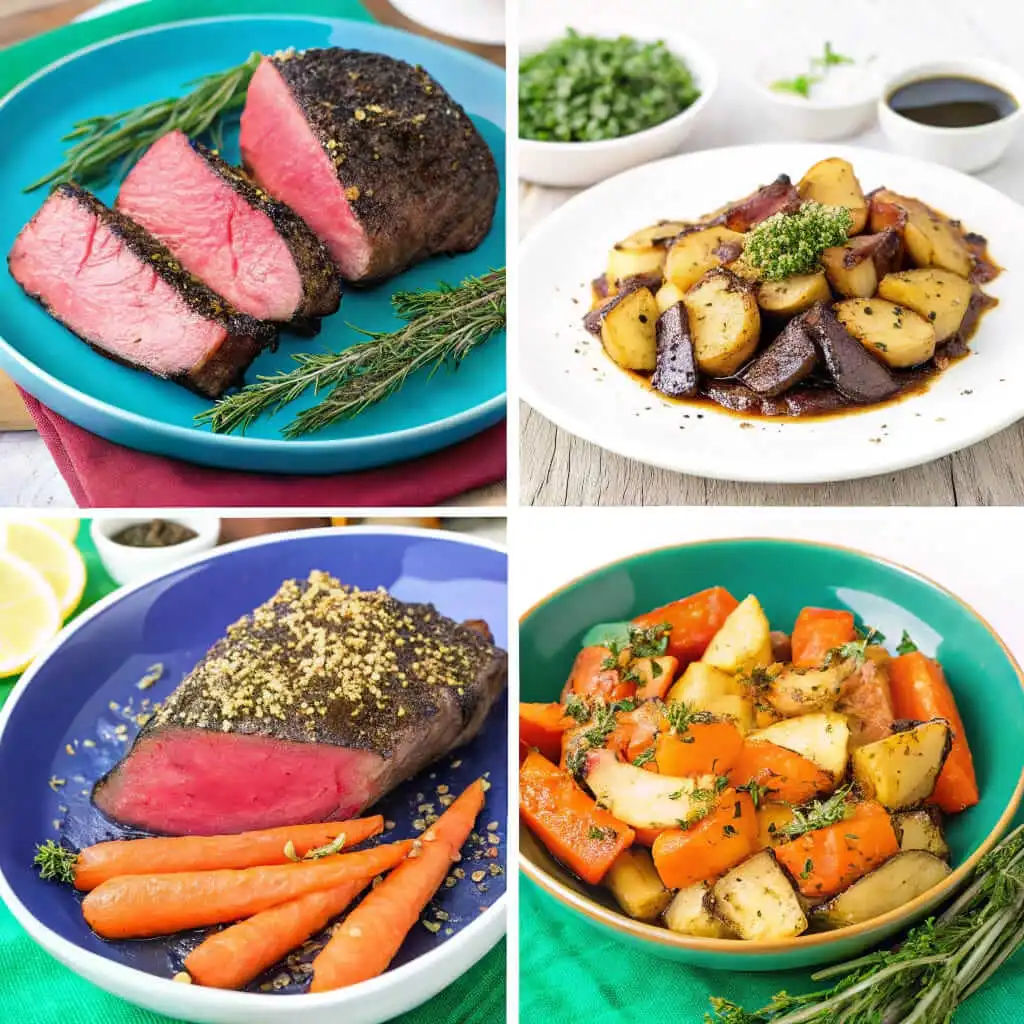
Frequently Asked Questions (FAQ)
Q: Can I use frozen vegetables?
A: Fresh vegetables roast best because they have better texture and flavor. However, if you’re short on time, you can use frozen root vegetables. Just thaw them slightly and pat them dry before roasting.
Q: How long can I store leftover roast beef and vegetables?
A: Leftover roast beef and vegetables can be stored in an airtight container in the refrigerator for up to 3-4 days.
Q: Can I freeze leftover roast beef?
A: Yes, you can freeze leftover roast beef. Slice it thinly and store it in freezer-safe bags or containers. It’s best to freeze the beef separately from the vegetables for optimal texture when reheating.
Q: What’s the best way to reheat roast beef without drying it out?
A: The best way to reheat roast beef is to add a little beef broth or gravy to a baking dish, place the sliced beef in the dish, cover it with foil, and reheat it in a low oven (around 300°F/150°C) until warmed through. You can also reheat it gently in a skillet with a bit of broth or gravy.
Q: Can I cook the roast beef and vegetables in a slow cooker?
A: While you can cook roast beef and root vegetables in a slow cooker, you won’t get the same roasted flavor and caramelized vegetables. Slow cooking is better for braising, resulting in very tender, almost shredded beef, rather than a nicely browned roast. For true “roast beef,” oven roasting is recommended.
Conclusion: Your Roast Beef Adventure Awaits!
“Cooking is at once child’s play and adult joy. And cooking done with care is an act of love.” – Craig Claiborne
Roast Beef with Roasted Root Vegetables is more than just a meal; it’s an experience. It’s about the comforting aromas filling your kitchen, the joy of sharing a delicious meal with loved ones, and the satisfaction of creating something truly nourishing and flavorful.
So, go ahead, and grab your favorite cut of beef and a medley of colorful root vegetables. Follow this guide, and you’ll be well on your way to creating a Roast Beef with Roasted Root Vegetables masterpiece that will impress your family and friends and become a cherished favorite in your recipe collection. Enjoy the delicious journey!
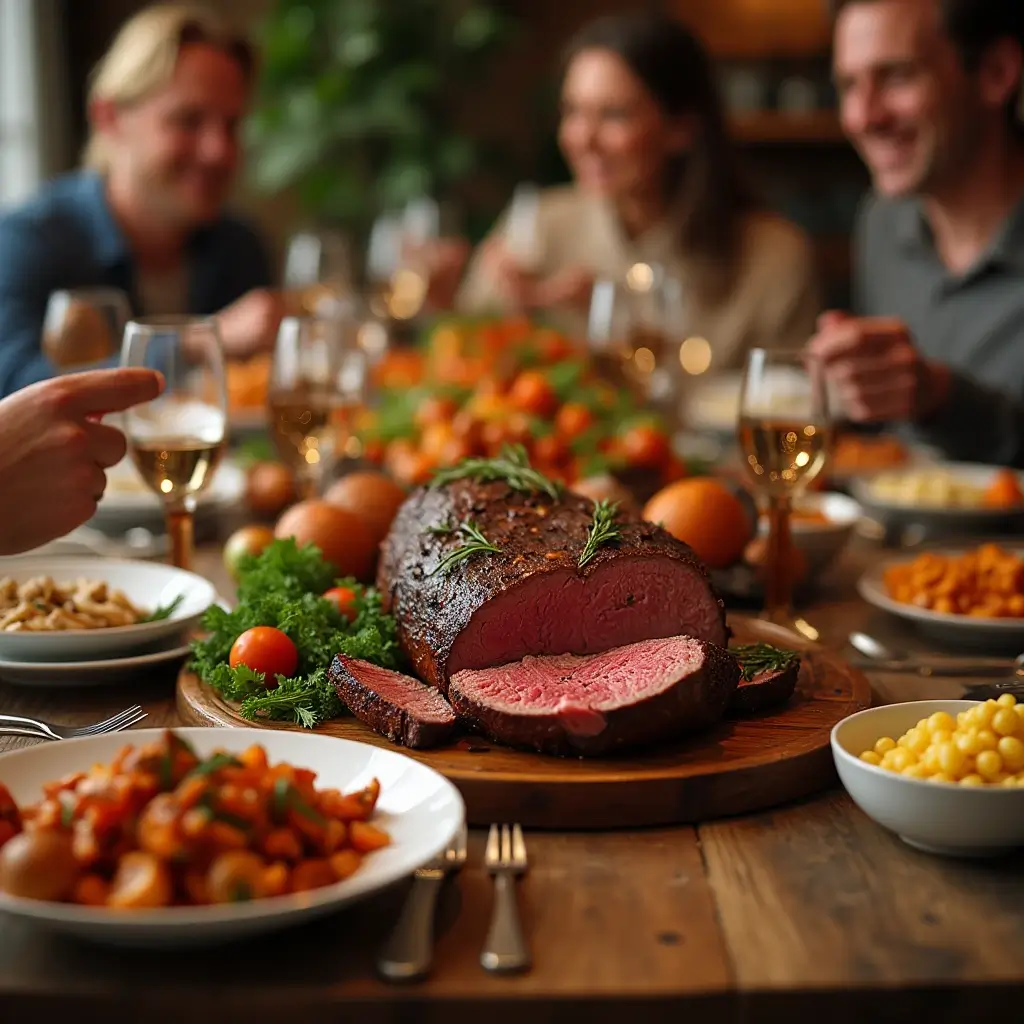
Don’t forget to check out our other resources for more special diet topic inspiration:
- Get 50+ Keto Lunch Ideas: Deliciously Easy Low-Carb Meals for You.
- Quick & Delicious Gluten Free Lunch Ideas: 5 Easy Recipes for Busy People
- Best 5-Star Gluten-Free Recipes: Delicious Dishes the Whole Family Will Love
Loved making this? Share your experience in a review!
There are no reviews yet. Be the first one to write one.

